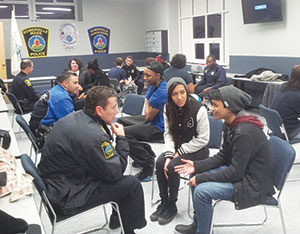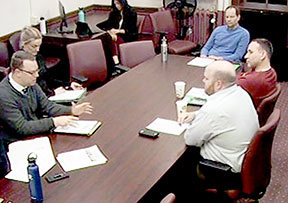
Somerville Police have been exploring measures aimed at mitigating gang violence among the city’s youth, according to a report to the Public Health and Public Safety Committee by Chief David Fallon.
By Anna Schaeffer
Members of the Somerville community and Somerville City Council Public Health and Public Safety Committee gathered on Wednesday, January 29, in the City Hall Sub-Committee Room to discuss matters of public health and safety.
First to be discussed was a request for information from the Somerville Police Department regarding a new restorative justice program formed in early 2019, similar to that used in Cambridge, Arlington, and Boston.
Restorative Justice programs are a method of criminal justice that focuses on the rehabilitation of offenders and reconciliation with the community at large. In response to the request, Chief of Police David Fallon said, “About three or four months ago we reached out to communities for restorative justice and have collaborated with Cambridge. We worked on three cases and formed three restorative circles. I attended two of them personally.”
Following the discussion on restorative justice, a request was made that the Somerville Police Department, Director of Health and Human services, the Director of Parks and Recreation and all other relevant groups discuss strategies to prevent youth violence and gun possession.

A restorative justice program was discussed at the latest meeting of the city’s Public Health and Public Safety Committee.
Chief Fallon stated first that prevention is the primary strategy used by the police department to combat violence and weapon possession in Somerville’s youth. Fallon cited the Cadet program, which seeks to engage graduating high school students with careers in public safety as a success in this regard.
Also, the Somerville Police Department established a basketball program at the Mystic Avenue Housing department and expanded the Junior Police Academy to three weeks, as part of a plan to move from enforcement to involvement as a means of curbing youth crime rates.
Changing response to crimes committed by minors and young adults is also a priority for Somerville police. Chief Fallon said, “We want to ensure that there are consequences for actions but also make sure that it’s something they can overcome in the future.”
Among the numerous community programs cited, Senior Crime Analyst Meredith Willis also mentioned the importance of the police department engaging positively with members of the community early on. “A lot of our individuals who have been arrested with firearms, their first-ever interaction with police is negative,” said Willis. “So I think that having positive interactions with law enforcement officials when they’re young is very important.”
Programs like ROCA, which assist high-risk young men to build lives outside of gang activity are also being utilized to mitigate youth violence in Somerville.
Closely related to youth violence, Chief Fallon reported to the council the state of affairs relating to ongoing gang activity in Somerville. Fallon said, “We do have gangs or cliques in the city that do at times feud with area gangs in Cambridge and Chelsea.”
However, gang activity numbers are shrinking according to Willis, who went on to say, “While the gangs, or more like groups or cliques, need to be taken seriously, they’re not comparable in size or organization to large gangs like MS13.” However, the fluidity and shifting nature of gangs make measuring exact numbers and statistics of gang activity difficult.
Ward 4 Councilor Jesse Clingan said, “Gangs can be folkloric, where kids will spray paint the names on sidewalks, and even though the gang itself isn’t present, maybe the allure is there. That’s the frustrating part, they can be so fluid.”
Also discussed at the meeting was the Licensing Commission’s investigation of the serving of alcohol to inebriated customers on East Broadway in hopes of addressing littering and over-serving.















Reader Comments